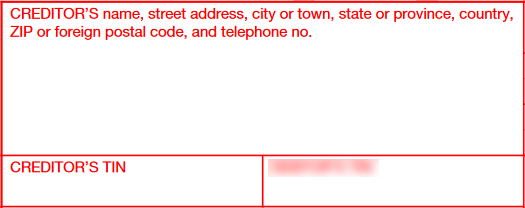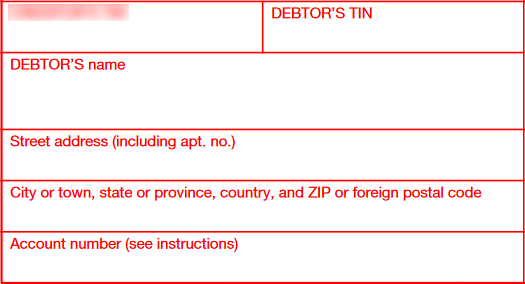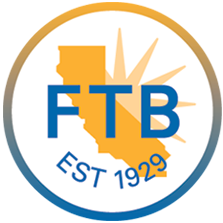Form 1099-C Instructions
Excise Tax Forms
Employment Tax Forms
Exempt Org. Forms
Extension Forms
FinCEN BOIR
General
What is IRS Form 1099-C?
IRS Form 1099-C, also known as the "Cancellation of Debt" form, is used to report any debt you have forgiven for someone else.
This form is required when a debt of $600 or more is canceled, such as forgiven credit card debt, written-off medical bills, or foreclosed mortgages. It notifies the IRS that a debt has been forgiven and provides a copy to the taxpayer who had the debt for their tax records.
Who needs to file Form 1099-C?
You need to file Form 1099-C if you are an "applicable financial entity" that forgives or cancels a debt of $600 or more owed by a taxpayer. This includes businesses such as:
- Banks
- Credit unions
- Collection agencies
- Healthcare providers (for medical bills)
- Mortgage lenders (for foreclosures)
In summary, if you are a business that forgives a significant debt, you will likely need to file a 1099-C.
When is the Form 1099-C due date?
Creditors must be aware of two important deadlines related to Form 1099-C:
Filing deadline with the IRS
The deadline for creditors to submit Form 1099-C to the IRS depends on the filing method:
- Electronic filing deadline: March 31, 2025
If you are e-filing Form 1099-C with the IRS, the deadline is March 31st of the year following the tax year for which the form is being issued - Paper filing deadline: February 28, 2025
If you are filing Form 1099-C with the IRS using traditional paper methods, the deadline is February 28th of the year following the tax year for which the form is issued.
Avoid the stress of last-minute 1099-C deadlines.
E-file with TaxZerone now and enjoy hassle-free IRS compliance and peace of mind.
Recipient copies deadline: January 31, 2025
Creditors must share copies of Form 1099-C to recipients by January 31st of the year following the relevant tax year. This allows debtors to accurately file their tax returns on time.
Missing these deadlines or providing incorrect information on Form 1099-C can lead to IRS penalties. To avoid potential penalties, creditors should take steps to ensure that Form 1099-C is filed and distributed both accurately and on time.
Form 1099-C penalty
If you miss filing Form 1099-C within the deadline, the IRS will impose a penalty. Here are the Form 1099-C penalty rates:
| Days late | Penalty per return |
|---|---|
| Up to 30 days | $60 |
| 31 days late through August 1 | $130 |
| After August 1 or not filed | $330 |
| Intentional disregard | $660 |
Why risk penalties?
E-file your 1099-C forms ahead of the deadline with TaxZerone.
Form 1099-C Instructions - How to fill out?
Let's see line-by-line instructions on how to fill out Form 1099-C.
Creditor details

Enter your name, complete address, and TIN (SSN if you're an individual; EIN if you're a business).
Debtor details

Enter the debtor’s name, complete address, and TIN (SSN for an individual; EIN for a business).
Box 1: Date of identifiable event

Enter the date when the debt was officially canceled.
Exception: If you voluntarily cancel a debt before an identifiable event occurs and choose to report this cancellation, enter the actual date you canceled the debt.
Box 2: Amount of Debt Discharged

Enter the total amount of debt canceled. This amount must not exceed the original debt minus any payments received, through any of the following:
- Settlement agreements
- Foreclosure sales
- Short sales that partially satisfied the debt
- Any other form of partial repayment
Box 3: Interest if Included in Box 2

If you included interest as part of the canceled debt amount in Box 2, enter that interest amount here in Box 3.
Important notes:
- Including interest in Box 2 is optional.
- If you did include interest in Box 2, you must report it in Box 3.
- If you did not include interest in Box 2, leave Box 3 blank.
Box 4: Debt description

Provide a specific description of the debt's origin. Examples include:
- Student loan
- Mortgage
- Credit card expenditure
Be as detailed as possible in your description.
Special case:
If you are filing a combined Form 1099-C and 1099-A, also include a description of the property associated with the debt.
Box 5: Debtor's Personal Liability for Debt

Check this box if the debtor was personally responsible for repaying the debt. When to check:
Put an "X" in the box if either of these conditions is true:
- The debtor was personally liable when the debt was originally created.
- The debt was modified, and the debtor was personally liable at the time of the most recent modification.
Box 6: Identifiable Event Code

Enter the appropriate code to indicate the nature of the identifiable event that led to the debt cancellation.
Report the debt as canceled on the earlier of:
- The date an identifiable event occurs, or
- The date of actual discharge (if you choose to file Form 1099-C for the year of cancellation)
Identifiable Event Codes
| Code | Description |
|---|---|
| A | Discharge in bankruptcy under title 11 of the U.S. Code (See "Exceptions" section for discharges not requiring reporting) |
| B | Cancellation due to receivership, foreclosure, or similar federal nonbankruptcy or state court proceeding |
| C | Cancellation due to statute of limitations expiration (Only when debtor's defense is upheld in final court judgment with expired appeal period) |
| D | Foreclosure election by creditor that legally bars further debt collection (Applies to mortgage lenders barred by local law after a "power of sale" exercise) |
| E | Cancellation under probate or similar proceeding |
| F | Discharge by agreement for less than full consideration (e.g., short sales) |
| G | Cancellation due to creditor's policy or decision to discontinue collection (Can be written policy or established business practice) |
| H | Other actual discharge occurring before any of the above identifiable events |
Box 7: Fair Market Value (FMV) of Property

This box applies only when filing a combined Form 1099-C and 1099-A. Enter the Fair Market Value (FMV) of the property as follows:
- For foreclosure, execution, or similar sale:
- Enter the FMV of the property
- Generally, use the gross foreclosure bid price as the FMV
- For abandonment or voluntary conveyance to the lender in lieu of foreclosure:
- Enter the appraised value of the property.
How to File Form 1099-C
You can file Form 1099-C, either online filing or by postal mail.
Electronic Filing (E-filing)
The IRS recommends e-filing due to its efficiency, accuracy, and quick processing notifications. To e-file Form 1099-C, use an IRS-authorized e-file service provider like TaxZerone.
Here's how to e-file Form 1099-C:
- Enter the required information:
- Creditor's name, address, and TIN
- Debtor's name, address, and TIN
- Debt details
- Review the entered information:
- Ensure all details are correct and complete.
- Transmit the form to the IRS:
- Send the form securely through the e-file service.
- Share a copy with the debtor:
- Provide a copy of the form to the debtor.
Paper filing
While less efficient, paper filing is still an option. Follow these steps to file Form 1099-C on paper:
- Download Form 1099-C:
- Visit the official IRS website (www.irs.gov) to download the form.
- Print the form.
- Complete the form:
- Use black ink to fill out all required fields, including:
- Payer's information
- Recipient's information
- Debt details
- Make a copy:
- Keep a copy for your records.
- Mail the original form:
- Send the original form to the IRS address specified in the Form 1099 General Instructions. The address varies based on your state. Refer to the "Where to Send Form 1099-C - Mailing Address" section to find the correct address for your state.
- Send a copy to the debtor:
- Provide a copy to the debtor by January 31st of the year following the reportable transaction.
Important considerations for paper filing:
- Mail forms early to ensure timely arrival before the deadline.
- Use certified mail for proof of timely filing
- Ensure all copies are legible.
Alternatively, you can file Form 1099-C electronically for faster processing and delivery, reducing the risk of delays or lost forms.
Where to send Form 1099-C - Mailing address
If you prefer paper filing, the mailing address for Form 1099-C varies depending on your business location. Below is a table summarizing the mailing address for Form 1099-C:
| If your business operates in or your legal residence is… | Mail Form 1099-C to… |
|---|---|
| Alabama, Arizona, Arkansas, Delaware, Florida, Georgia, Kentucky, Maine, Massachusetts, Mississippi, New Hampshire, New Jersey, New Mexico, New York, North Carolina, Ohio, Texas, Vermont, Virginia | Internal Revenue Service Austin Submission Processing Center P.O. Box 149213 Austin, TX 78714 |
| Alaska, Colorado, Hawaii, Idaho, Illinois, Indiana, Iowa, Kansas, Michigan, Minnesota, Missouri, Montana, Nebraska, Nevada, North Dakota, Oklahoma, Oregon, South Carolina, South Dakota, Tennessee, Utah, Washington, Wisconsin, Wyoming | Department of the Treasury IRS Submission Processing Center P.O. Box 219256 Kansas City, MO 64121-9256 |
| California, Connecticut, District of Columbia, Louisiana, Maryland, Pennsylvania, Rhode Island, West Virginia | Department of the Treasury IRS Submission Processing Center 1973 North Rulon White Blvd. Ogden, UT 84201 |
| Outside the United States | Internal Revenue Service, Austin Submission Processing Center, P.O. Box 149213, Austin, TX 78714 |
How to E-File Form 1099-C with TaxZerone
Before you start e-filing Form 1099-C, ensure you have all the necessary information to facilitate a smooth and efficient filing experience. Here’s what you need to gather:
Required information for filing Form 1099-C:
- Creditor details
- Debtor details
- Amount of debt discharged
- Interest
- Fair market value of property
Steps to e-file Form 1099-C using TaxZerone:
Step 1: Complete Form 1099-C
Open Form 1099-C and fill out the necessary fields with the information you have gathered.
Step 2: Review and transmit the return
Carefully review all the entered information to ensure accuracy. Once verified, transmit the completed Form 1099-C to the IRS.
Step 3: Provide the debtor copy
After successfully transmitting the form to the IRS, share a copy of the completed Form 1099-C to the debtor.
Benefits of E-Filing Form 1099-C with TaxZerone
E-filing Form 1099-C with TaxZerone offers several advantages, including:
- IRS form validations: Automated checks for errors or missing information to ensure accuracy before submission.
- Email debtor copies: Share debtor copies of Form 1099-C via email and eliminate the need for manual mailing.
- Secure portal access (ZeroneVault): Debtors can access their return copies anytime, anywhere through the secure ZeroneVault portal.
- Competitive pricing: Industry-leading rates, starting as low as $0.59 per form.
By e-filing with TaxZerone, you can simplify your Form 1099-C filing, save time, and reduce errors.




